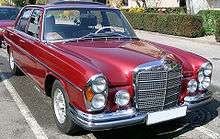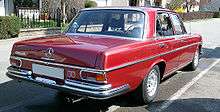Mercedes-Benz W108/W109
The Mercedes-Benz W108 and W109 are luxury cars produced by Mercedes-Benz from 1965 through to 1972 and 1973 in North America only. The line was an update of the predecessor W111 and W112 fintail sedans. The cars were successful in West Germany and in export markets including North America and Southeast Asia. During the seven-year run, a total of 383,361 units were manufactured.
| Mercedes-Benz W108 | |
|---|---|
_sedan_(2015-07-09)_01.jpg) | |
| Overview | |
| Manufacturer | Mercedes-Benz |
| Production | 1965–1972 (1973 North America only) 383,361 built W108: 364,699 W109: 18,662 (incl. 300 SEL 6.3: 6,526)[1] |
| Assembly | West Germany: Stuttgart |
| Designer | Paul Bracq , Friedrich Geiger (1963) |
| Body and chassis | |
| Class | Full-size luxury car (F) |
| Body style | 4-door sedan |
| Layout | FR layout |
| Related | Mercedes-Benz W111 Mercedes-Benz W112 Mercedes-Benz W113 |
| Powertrain | |
| Engine | |
| Transmission | 3-speed automatic 4-speed manual 5-speed manual 4-speed automatic |
| Chronology | |
| Predecessor | Mercedes-Benz W111 Mercedes-Benz W112 |
| Successor | Mercedes-Benz W116 |
- See Mercedes-Benz S-Class for a complete overview of all S-Class models.
Since the W108 and W109 were only available as 4-door models, similarly squarish 2-door W111 and W112 coupés and cabriolets filled those niches and are frequently mistaken for them.
Model history
The car's predecessors, the Mercedes-Benz W111 (1959–71) and W112 (1961–67), helped Mercedes-Benz develop greater sales and achieve economy of scale production, reducing both manufacture time and cost. Throughout the 1950s, Mercedes-Benz had been producing the coachwork 300 S and 300 SL and all but hand-built 300 Adenauers alongside conveyor assembled Pontons (190, 190 SL and 220) etc. Unifying the entire Mercedes-Benz range into the fintail (German: Heckflosse) reduced production onto a single automobile platform.
However, fashion trends in the early 1960s changed rapidly. By the time the Paul Bracq-designed 2-door coupé and cabriolet W111s were launched, the predecessor W111 sedan's fins lost their chrome trim and sharp appearance. The arrival of the W113 'Pagoda' coupé and cabriolet in 1963 saw them further buried into the trunk's contour. Finally, they disappeared completely on the W100 600 in 1963.
The evolution of the W111 began under the leadership of Bracq in 1961 and ended in 1963. Although the fins' departure was the most visible change, the W108 had a lower body waist line and increased glass area - the windscreen alone was 17% larger than W111's - prominent enough to be referred to as a "greenhouse". The cars had a 60 mm lower ride and 15 mm wider doors. The result was a visibly newer-looking, sleeker car with an open and spacious interior.[2]
Differences between W108 and W109
Due to the success of long wheelbase 300 SE Lang (W112), which was intended as an interim car between 300 "Adenauer" (W189) and "Grosser Mercedes" 600 (W100), Mercedes-Benz continued to offer two wheelbase lengths for W108/W109. Initially, the wheelbase lengths denoted W108 (standard) and W109 (long). For 1968 model year, this distinction changed with the introduction of 280 SEL that retained W108, rather than W109, chassis designation.
The larger 3-litre six-cylinder inline engine (300 SEL) were exclusive to W109 with odd exception of standard wheelbase 300 SEb (1965–1967), which was designated as W108. The smaller six-cylinder inline engines (250 S/SE and 280 S/SE/SEL) were assigned to W108 only. Both eventually received the V8 engines in 1967 (W109) and 1970 (W108).
W109 was more luxuriously appointed than W108, featuring burled walnut dashboards, automatic transmission, and power windows along with optional air conditioning system.
The W108 and W109 had different types of suspension systems: W108 retained the steel coil springs and oil-filled shock absorbers while W109 used the self-levelling air suspension.
First Series, 1965–1967
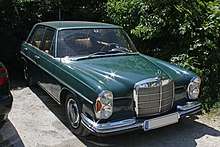
The W108/W109 premiered at the Frankfurt Auto Show in 1965. The initial model range consisted of three W108s (250 S, 250 SE, and 300 SEb) and a sole W109 (300 SEL). The six-inline engines were carried over from the previous generation with mechanical refinements. The 2.2-litre M180 engine was enlarged to 2.5 litres while the fuel-injected 3-litre M189 version was carried over from "300 Adenauer".
The 250 S was fitted with 2,496 cc M108 engine with dual two-barrel downdraft carburettors producing 96 kW (131 PS; 129 bhp) at 5,400 rpm. It could accelerate to 100 km/h (62 mph) in 13 seconds for manual and 14 for automatic. The top speed was 182 km/h (113 mph) for manual and 177 km/h (110 mph) for automatic. The 250 SE had the same engine as 250 S except for fuel injection system and different engine designation (M129). With increased engine output of 110 kW (150 PS; 148 bhp) at 5,500 rpm, 250 SE was one second faster to 100 km/h than 250 S and had higher top speed of 193 km/h (120 mph) for both manual and automatic versions.
Both 300 SEb and 300 SEL were fitted with 2,966 cc M189 engine. The engine was an updated version of M186, originally developed in 1951 for Type 300 "Adenauer", with Bosch mechanical fuel-injection system that caliberated the optimal fuel mixture automatically based on throttle pedal position and movement, engine speed, atmospheric pressure, water temperature, and driving conditions. The engine's output was 125 kW (170 PS; 168 bhp) at 5,400 rpm, and 300 SEb and 300 SEL could accelerate to 100 km/h (62 mph) in 12 seconds and reach the top speed of 200 km/h (124 mph) (195 km/h (121 mph) with automatic transmission).
The production figures for the first series from 1965 to 1967 showed 129,858 of 250 S/250 SE and 5,106 of 300 SEb/300 SEL. The tiny production figure of 300 SEb/300 SEL reflected the higher sales price with luxurious appointments, exclusivity, and smaller global market share.
300 SEL 6.3
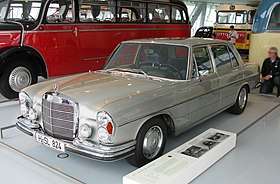
In 1966 company engineer Erich Waxenberger transplanted a massive 6.3 L Mercedes-Benz M100 V8 from the company's flagship 600 (W100) into a W109 chassis, creating the first Q-car from Mercedes-Benz. Full-scale production of 300 SEL 6.3 began in December 1967. 300 SEL 6.3 could reach 100 km/h (62 mph) in 6.5 seconds and the top speed of 220 km/h (137 mph), making it the quickest production sedan, a title it held for many years.
Second Series, 1967–1972
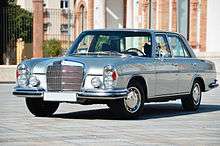
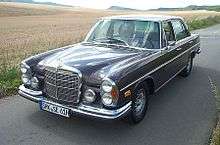
To coincide with the launch of new smaller executive model, "/8" (Stroke Eight), to be slotted below W108/W109, the inline six engine range was revised in 1967. The 2.5-litre engine was enlarged to 2,778 cc (2.8 litres) and renamed as M130 for both carburetted (103 kW (140 PS; 138 bhp)) and fuel injected 118 kW (160 PS; 158 bhp) versions.
250 S and 250 SE were renamed as 280 S and 280 SE in November 1967 while 250 S was still offered in some export markets until March 1969. In January 1968, a long wheelbase variation, 280 SEL, was introduced for the first time. The 280 S could reach 100 km/h (62 mph) in 12.5 seconds and top speed of 185 km/h (115 mph) (180 km/h (112 mph) with automatic transmission). The 280 SE and 280 SEL accelerated to 100 km/h (62 mph) in 10.5 seconds with top speed of 193 km/h (120 mph) and 190 km/h (118 mph) respectively.
The standard wheelbase 300 SEb was dropped while 300 SEL 2.8 obtained 2.8-litre engine with higher output 125 kW (170 PS; 168 bhp), replacing the M186 engine. The acceleration to 100 km/h (62 mph) was 10.5 seconds, and the top speed was 200 km/h (124 mph).
Following the strong reception of limited production V8-powered 300 SEL 6.3 in 1967, Mercedes-Benz offered the all-new 3.5-litre M116 V8 engine with new Bosch D-Jetronic electronic fuel injection in 1969. The V8 engine would move W108/W109 further upmarket in many export markets and allow them to be more competitive in the United States where many passenger vehicles, especially the American luxury marques, were fitted with V8 engines. The new 147 kW (200 PS; 197 bhp) V8 engine was first fitted to W109 in August 1969 as 300 SEL 3.5 then to W108 in July 1970 as 280 SE 3.5 and 280 SEL 3.5.
The 3.5-litre V8 engine was bored out to 4,520 cc (4.5 litres) as to compensate for the loss of power following the changes in emission control regulations and due to lower fuel octane rating in the United States. The larger V8 engine was designated as M117 and had the same output figures as 3.5-litre V8 engine. It was initially exclusive for the United States from 1971 to 1973 until the introduction of 450 SE/450 SEL (W116) which went on sale worldwide in September 1972 along with 450 SL (R107) and 450 SLC (C107). 280 SE 4.5/280 SEL 4.5 and 300 SEL 4.5 were introduced in the spring of 1971.
The 300 SEL 2.8 was dropped in January 1970 since 300 SEL 3.5 was selling better and had better performance. The production of 280 SEL ended in April 1971, leaving 280 S and 280 SE as sole models with six-cylinder inline engines until the end of W108/W109 production in 1972, following the introduction of W116.
Transmission
The standard transmission for Europe was a four-speed manual gearbox. A four-speed automatic option was also available. Unusual among mainstream European automakers of the time, Mercedes developed and built their own automatic transmission system.[3] A five-speed manual gearbox was offered for six-cylinder inline engines only from 1969 to 1972, though a few customers opted for it.
When the 3.5-litre V8 engine was introduced in 1969, the sole transmission choice was a four-speed automatic with fluid coupling. The customers could request the four-speed manual transmission with price reduction if they inclined so. As for 4.5-litre V8 engine for the United States, the transmission was three-speed automatic with torque converter.
Models
W108
| Model | Chassis code | Production date | Number built | Engine |
|---|---|---|---|---|
| 250 S | W108.012 | 07/65–03/69 | 74,677 | 2.5 L M108 I6 |
| 250 SE | W108.014 | 08/65–01/68 | 55,181 | 2.5 L M129 I6 |
| 300 SEb | W108.015 | 08/65–12/67 | 2,737 | 3.0 L M189 I6 |
| 280 S | W108.016 | 11/67–09/72 | 93,666 | 2.8 L M130 I6 |
| 280 SE | W108.018 | 11/67–09/72 | 91,051 | 2.8 L M130 I6 |
| 280 SEL | W108.019 | 01/68–04/71 | 8,250 | 2.8 L M130 I6 |
| 280 SE 3.5 | W108.057 | 07/70–09/72 | 11,309 | 3.5 L M116 V8 |
| 280 SEL 3.5 | W108.058 | 06/70–08/72 | 951 | 3.5 L M116 V8 |
| 280 SE 4.5 | W108.067 | 04/71–11/72 | 13,527 | 4.5 L M117 V8 |
| 280 SEL 4.5 | W108.068 | 05/71–11/72 | 8,173 | 4.5 L M117 V8 |
W109
| Model | Chassis code | Production date | Number built | Engine |
|---|---|---|---|---|
| 300 SEL | W109.015 | 09/65–12/67 | 2,369 | 3.0 L M189 I6 |
| 300 SEL | W109.016 | 12/67–01/70 | 2,519 | 2.8 L M130 I6 |
| 300 SEL 6.3 | W109.018 | 12/67–09/72 | 6,526 | 6.3 L M100 V8 |
| 300 SEL 3.5 | W109.056 | 08/69–09/72 | 9,483 | 3.5 L M116 V8 |
| 300 SEL 4.5 | W109.057 | 05/71–10/72 | 2,533 | 4.5 L M117 V8 |
Timeline
| Type | Chassis | 1965 | 1966 | 1967 | 1968 | 1969 | 1970 | 1971 | 1972 |
| Sedan | W108 | 250 S | |||||||
| 250 SE | |||||||||
| 280 S | |||||||||
| 280 SE | |||||||||
| 280 SEL | |||||||||
| 300 SEb | |||||||||
| 280 SE 3.5 | |||||||||
| 280 SEL 3.5 | |||||||||
| 280 SE 4.5 | |||||||||
| 280 SEL 4.5 | |||||||||
| W109 | 300 SEL | ||||||||
| 300 SEL 3.5 | |||||||||
| 300 SEL 4.5 | |||||||||
| 300 SEL 6.3 | |||||||||
Technical info
| Mercedes-Benz | 250 S (W108 II) |
250 SE (W108 III) |
300 SE (W108 IV) |
280 S (W108 V28) |
280 SE (W108 E28) |
280 SEL (W108 E28) |
280 SE 3.5 (W108 E35)† |
|---|---|---|---|---|---|---|---|
| Chassis code: | W108.012 | W108.014 | W108.015 | W108.016 | W108.018 | W108.019 | W108.057 |
| Produced: | 07/65 – 03/69 | 08/65 – 01/68 | 08/65 – 12/67 | 11/67 – 09/72 | 01/68 – 04/71 | 07/70 – 09/72 | |
| Units: | 74,677 | 55,181 | 2,737 (includes 300 SEL) | 93,666 | 91,051 | 8,250 | 11,309 |
| Engine: | 2497 cc M108 I6 | 2497 cc M129 I6 | 2996 cc M189 I6 | 2778 cc M130 I6 | 3499 cc M116 V8 | ||
| Bore x Stroke: | 82 mm (3.2 in) x 78.8 mm (3.1 in) | 85 mm (3.3 in) x 88 mm (3.5 in) | 86.5 mm (3.4 in) x 78.8 mm (3.1 in) | 92 mm (3.6 in) x 65.8 mm (2.6 in) | |||
| Max. Power at rpm: | 130 PS (96 kW; 128 hp) at 5,400 | 150 PS (110 kW; 148 hp) at 5,500 | 170 PS (125 kW; 168 hp) at 5,400 | 140 PS (103 kW; 138 hp) at 4,200 | 160 PS (118 kW; 158 hp) at 5,500 | 160 PS (118 kW; 158 hp) at 5,500 | 200 PS (147 kW; 197 hp) at 5,800 |
| Max. Torque at rpm: | 194 N⋅m (143 lb⋅ft) at 4000 | 216 N⋅m (159 lb⋅ft) at 4,200 | 250 N⋅m (184 lb⋅ft) at 4,000 | 223 N⋅m (164 lb⋅ft) at 3,600 | 240 N⋅m (177 lb⋅ft) at 4,250 | 240 N⋅m (177 lb⋅ft) at 4,250 | 286 N⋅m (211 lb⋅ft) at 4,000 |
| Compression Ratio: | 9.0: 1 | 9.5: 1 | 8.8: 1 | 9.0: 1 | 9.5: 1 | 9.5: 1 | 9.5: 1 |
| Fuel feed: | Two 2-bbl Zenith 35/40 | Mechanical Bosch injection | Two 2-bbl Zenith 35/40 | Mechanical Bosch injection | Bosch D-Jetronic | ||
| Fuel tank capacity: | 82 L (21.7 US gal; 18.0 imp gal) | ||||||
| Valvetrain: | SOHC, duplex chain | SOHC, duplex chain | SOHC, duplex chain | ||||
| Cooling: | Water | ||||||
| Gearbox: | 4-speed manual w/ column or floor shifter or 4-speed automatic rear wheel drive, standard axle ratio 3.92:1 or 3.69:1 (V8: 3.46:1) | ||||||
| Electrical system: | 12 volt | ||||||
| Front suspension: | Double wishbones, coil springs, stabilising bar | ||||||
| Rear suspension:: | Low-pivot swing axle, radius arms, coil springs | ||||||
| Brakes: | Disc brakes (Ø 273 mm (10.7 in) front, 279 mm (11.0 in) rear), power assisted | ||||||
| Steering: | Recirculating ball steering, manual or servo-assisted | ||||||
| Body structure: | Sheet steel, monocoque (unibody) construction | ||||||
| Dry weight: | 1,470 kg (3,241 lb) | 1,510 kg (3,329 lb) | 1,575 kg (3,472 lb) | 1,520 kg (3,351 lb) | 1,560 kg (3,439 lb) | 1,575 kg (3,472 lb) | 1,610 kg (3,549 lb) |
| Loaded weight: | 1,940 kg (4,277 lb) | 1,980 kg (4,365 lb) | 2,060 kg (4,542 lb) | 1,960 kg (4,321 lb) | 1,985 kg (4,376 lb) | 2,000 kg (4,409 lb) | 2,055 kg (4,530 lb) |
| Track front/ rear: | 1,482 mm (58.3 in) / 1,485 mm (58.5 in) | ||||||
| Wheelbase: | S/SE: 2,750 mm (108.3 in) SEL: 2,850 mm (112.2 in) | ||||||
| Length: | S/SE: 4,900 mm (192.9 in) SEL: 5,000 mm (196.9 in) | ||||||
| Width: | 1,810 mm (71.3 in) | ||||||
| Height: | 1,440 mm (56.7 in) | ||||||
| Tyre/Tire sizes: | 7.35 H 14 or 185 HR 14 | 185 VR 14 | |||||
| Top speed: | 182 km/h (113 mph) | 193 km/h (120 mph) | 200 km/h (124 mph) | 185 km/h (115 mph) | 193 km/h (120 mph) | 190 km/h (118 mph) | 210 km/h (130 mph) |
| Fuel Consumption (estimate): | 15.5 litres per 100 kilometres (18.2 mpg‑imp; 15.2 mpg‑US) | 18.0 litres per 100 kilometres (15.7 mpg‑imp; 13.1 mpg‑US) | 10.5 litres per 100 kilometres (27 mpg‑imp; 22 mpg‑US) | 11 litres per 100 kilometres (26 mpg‑imp; 21 mpg‑US) | 18.5 litres per 100 kilometres (15.3 mpg‑imp; 12.7 mpg‑US) | ||
| Price Germany USA: | DM 15,300 $5,747[4] | DM 16,850 $6,385 | DM 21,500 $8,048 | DM 17,000 $5,897 | DM 18,600 $6,222 | DM 21,230 $6,622 | DM 24,920 $10,076 |
| Notes: | † North American version (280 SE/SEL 4.5: approx 22,000 units) with 4.5 liter V8, 195 hp/278 lb ft | ||||||
| Mercedes-Benz | 300 SEL (W109 III) | 300 SEL (W109 E28) | 300 SEL 3.5 (W109 E35/1)† | 300 SEL 4.5 (W109 E45) | 300 SEL 6.3 (W109 E63) | ||
|---|---|---|---|---|---|---|---|
| Chassis code | W109.015 | W109.016 | W109.056 | W109.057 | W109.018 | ||
| Produced: | 09/65 – 12/67 | 12/67 – 01/70 | 08/69 – 09/72 | 05/71 – 10/72 | 12/67 – 09/72 | ||
| Units: | 2,369 | 2,519 | 9,483 | 2,533 | 6,526 | ||
| Engine: | 2996 cc M189 I6 | 2778 cc M130 I6 | 3499 cc M116 V8 | 4520 cc M117 V8 | 6333 cc M100 V8 | ||
| Bore x Stroke: | 85 mm (3.3 in) x 88 mm (3.5 in) | 86.5 mm (3.4 in) x 78.8 mm (3.1 in) | 92 mm (3.6 in) x 65.8 mm (2.6 in) | 92 mm (3.6 in) x 85 mm (3.3 in) | 103 mm (4.1 in) x 95 mm (3.7 in) | ||
| Max. Power at rpm: | 170 PS (125 kW; 168 hp) at 5,400 | 170 PS (125 kW; 168 hp) at 5,750 | 200 PS (147 kW; 197 hp) at 5,800 | 198 PS (146 kW; 195 hp) at 4,500 | 250 PS (184 kW; 247 hp) at 4,000 | ||
| Max. Torque at rpm: | 250 N⋅m (184 lb⋅ft) at 4,000 | 240 N⋅m (177 lb⋅ft) at 4,500 | 286 N⋅m (211 lb⋅ft) at 4,000 | 358 N⋅m (264 lb⋅ft) at 3,000 | 500 N⋅m (369 lb⋅ft) at 2,800 | ||
| Compression Ratio: | 8.8: 1 | 9.5: 1 | 9.5: 1 | 8.0: 1 | 9.0: 1 | ||
| Fuel feed: | Mechanical Bosch injection | Bosch D-Jetronic | Mechanical Bosch injection | ||||
| Fuel tank capacity: | 82 L (21.7 US gal; 18.0 imp gal) | 105 L (27.7 US gal; 23.1 imp gal) | |||||
| Valvetrain: | SOHC, duplex chain | ||||||
| Cooling: | Water | ||||||
| Gearbox: | 4-speed manual w/ column or floor shifter or 4-speed automatic rear wheel drive, standard axle ratio 3.92:1 or 3.69:1 (V8: 3.46:1) | 3-speed automatic rear wheel drive, standard axle ratio 3.23:1 | 4-speed automatic rear wheel drive, standard axle ratio 2.85:1 | ||||
| Electrical system: | 12 volt | ||||||
| Front suspension: | Double wishbones, air springs, rubber springs, stabilising bar | ||||||
| Rear suspension:: | Swing axle, radius arms, air and additional rubber springs | ||||||
| Brakes: | Disc brakes (Ø 273 mm (10.7 in) front, 279 mm (11.0 in) rear), power assisted | ||||||
| Steering: | Recirculating ball steering, servo-assisted | ||||||
| Body structure: | Sheet steel, monocoque (unibody) construction | ||||||
| Dry weight: | 1,655 kg (3,649 lb) | 1,695 kg (3,737 lb) | 1,730 kg (3,814 lb) | 1,759 kg (3,878 lb) | 1,830 kg (4,034 lb) | ||
| Loaded weight: | 2,140 kg (4,718 lb) | 2,120 kg (4,674 lb) | 2,170 kg (4,784 lb) | 2,222 kg (4,899 lb) | 2,265 kg (4,993 lb) | ||
| Track front/ rear: | 1,482 mm (58.3 in) 1,485 mm (58.5 in) | 1,482 mm (58.3 in) 1,490 mm (58.7 in) | |||||
| Wheelbase: | 2,850 mm (112.2 in) | ||||||
| Length: | 5,000 mm (196.9 in) | ||||||
| Width: | 1,810 mm (71.3 in) | ||||||
| Height: | 1,440 mm (56.7 in) | 1,470 mm (57.9 in) | |||||
| Tyre/Tire sizes: | 185 HR 14 | 185 VR 14 | 195 VR 14 or
(205/70 VR 14) | ||||
| Top speed: | 200 km/h (124 mph) | 195 km/h (121 mph) | 200 km/h (124 mph) | 205 km/h (127 mph) | 221 km/h (137 mph) | ||
| Fuel Consumption (estimate): | 18.0 litres per 100 kilometres (15.7 mpg‑imp; 13.1 mpg‑US) | 16.5 litres per 100 kilometres (17.1 mpg‑imp; 14.3 mpg‑US) | 18.5 litres per 100 kilometres (15.3 mpg‑imp; 12.7 mpg‑US) | 16.3 litres per 100 kilometres (17.3 mpg‑imp; 14.4 mpg‑US) | 21.0 litres per 100 kilometres (13.5 mpg‑imp; 11.2 mpg‑US) | ||
| Price Germany USA: | DM 28,600 $9,910[4] | DM n.a. $9,400 | DM 31,025 $11,327 | DM N/A $11,327 | DM 39,160 $15,122 | ||
| Notes: | † North American version (300 SE/SEL 4.5: approx 2,500 units) with 4.5 liter V8, 195 hp/278 lb ft (MY 1972) | ||||||
References
- Oswald, Werner (2001). Deutsche Autos 1945-1990, Band 4 (in German). Stuttgart: Motorbuch Verlag. ISBN 3-613-02131-5.
- Bernd. "Mercedes 250S, SE W108: Mercedes elegance at its best". Benz Books. Retrieved 15 March 2015.
- Garnier, Peter, ed. (2 February 1967). "Autocar Road Test: Mercedes-Benz 250 SE". Autocar. 126 (3703): 17–23.
- Covello, Mike (2002). Standard Catalog of Imported Cars 1946-2002. Iola: Krause Publication. pp. 533–536. ISBN 0-87341-605-8.
External links
| Wikimedia Commons has media related to Mercedes-Benz W108. |
| Wikimedia Commons has media related to Mercedes-Benz W109. |
- Curbside Classic: 1966 Mercedes 250S (W108) – Cadillac Und Lincoln Kaput – a retrospective of the W108
- Mercedes Benz W108 website
- W108/W109 Tom's Mercedes Benz 108/109 Resource Site
- RollHard - 1972 Mercedes Benz 280SE
